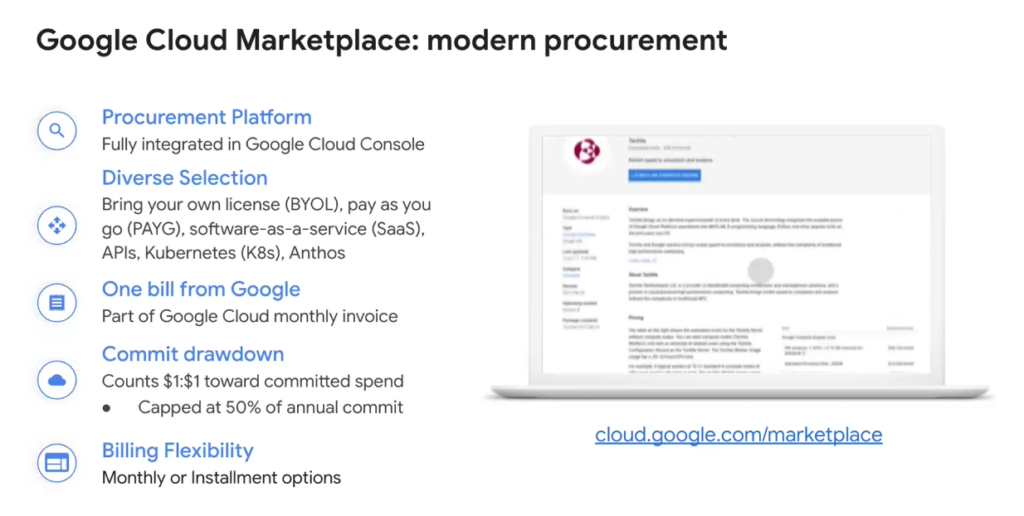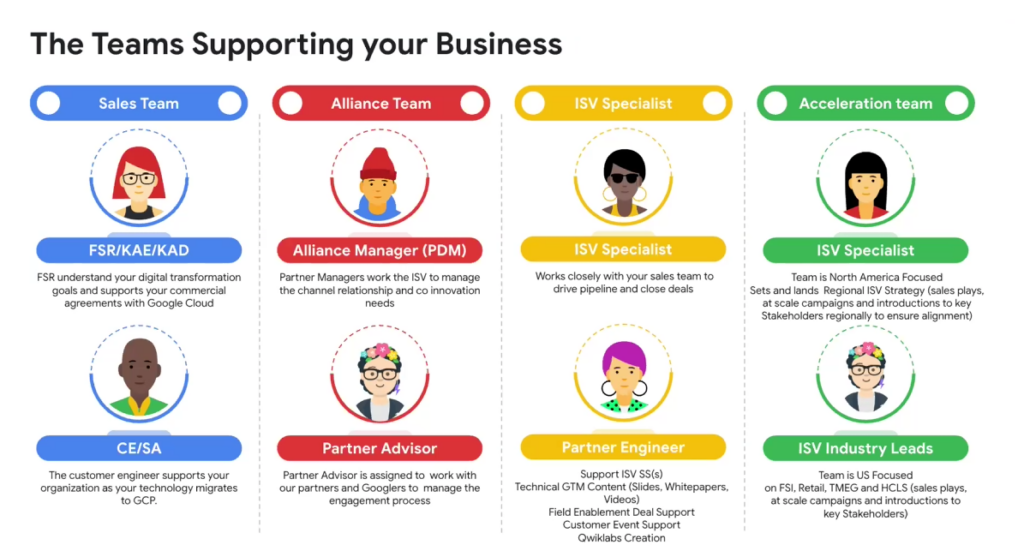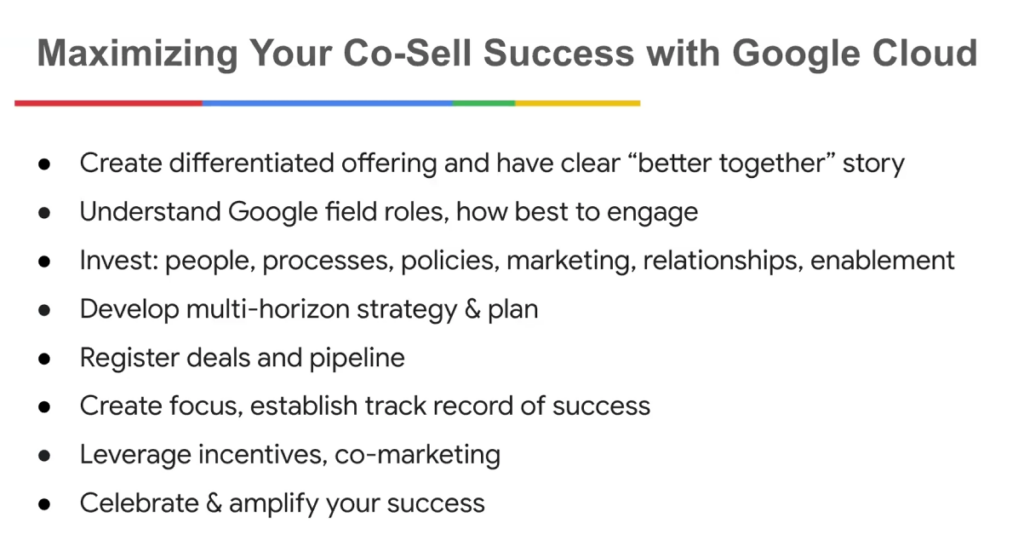

Google Cloud Marketplace is the primary online destination for discovering and acquiring solutions that run on or with Google Cloud. Google has created a universal catalog to simplify the process of finding, buying, and deploying a vast array of business software. By modernizing procurement and purchasing, they’ve transforming how businesses acquire technology. Many large enterprises have already embraced this marketplace-first approach, recognizing its efficiency and reduced friction compared to traditional methods.

Today, many marketplaces have massive revenue backlogs in the billions of dollars, and Google is no exception.Customers are making much larger cloud commitments because they get favorable discounting and other incentives including cloud credits, professional services for migration, etc. So as a result, customers are drawing down on that backlog through cloud marketplace spend. This presents an enormous opportunity for emerging companies who are interested in shortening their own sales cycles with large organizations. We invited Dai Vu, Managing Director, Cloud Marketplace & ISV GTM Initiatives to share insights and best practices about both how to get onboarded, and best leverage the platform as a high growth startup.
At a high level, companies are increasingly procuring software via the cloud marketplaces. It’s the primary location where partners want to sell their solutions, and it’s where customers want to buy. Some analyst firms like Canalys have projected that by 2025, cloud marketplaces will be at $50B+, with some projecting $100B+ by 2026. So far, sales have been doubling every year, which is much faster than cloud as a service segment. And on the surface, these numbers sound very impressive, but if you benchmark that to the percentage of B2B software spend or cloud spend, that’s less than 5-10% of the total market. In other words, a lot of upside still remains to be seen.
Historically, the largest categories on the marketplace were those tied to cloud migration, so think: security, database, and infrastructure. But these days, interest has begun to broaden. Many new categories are popping up including things like generative AI and commercial datasets. The Google Cloud Marketplace is also looking to launch a professional services category as well, in order to help remove some of the friction for startups looking to sell their core products as part of those offerings. And surprisingly, many channel partners will also be participating in this growth as well. Enterprise customers are typically involved in very complex sales processes and negotiations, sometimes involving multiple partners, and if customers want to adopt a broader set of portfolio solutions through the marketplace, they’re going to rely on partners to work with them where they are at. So, this won’t be an either/or situation – customers will still want and need channel partners and service partners alongside the marketplace.
Beyond committed spend, however, customers engage with the marketplace for a number of other reasons, things like having a scalable repeatable process, consolidated billing agreements, better cost and spend management, governance, etc. There’s a lot of stickiness there today. Furthermore, Google’s marketplace attempts to treat first and third-party solutions equally. As an example, Google has Vertex AI Model Garden, but if there are third-party solutions that make sense, those should be surfaced as well. For example, maybe it’s a vector database that the customer needs to look at – customers can easily find and procure them via the same streamlined process. Today, SaaS, VMs, and APIs dominate the marketplace, but this is expanding to items such as foundational models, commercial datasets, and other areas.
Step 1: Telling a “Better Together” Story
Today there are 1100 unique partners on the marketplace. Of course that’s spread across different pillars, but you’re still fighting for attention, and there are different ways to approach that: first and foremost, you want to figure out how your offering is truly differentiated, and then you want to build a “better together” story – this is the foundation for everything. For account teams to really start to pay attention, they have to understand how your product aligns well with Google Cloud and how the marriage between your offering and Google Cloud will ultimately benefit end customers, and a lot of that has to do with product integration. So this can be an opportunity to do some technical integration (work with BigQuery for data analytics, Vertex AI and Gemini for AI, Chronicle for security, etc.). You have to figure out where the opportunity is.
The other piece is understanding the consumption aspect. What kind of consumption does your product drive? There’s direct consumption that your product may drive in your partner tenant over the course of delivering your service, but again, when you have this technical integration, you might be driving things that happen with BigQuery or other sort of customer tenant resources. You need to understand what that adoption and usage dynamic looks like and communicate that because the reps are very motivated to drive and get those meters spinning. So getting that “Better Together” story, how you integrate and what kind of consumption you’re driving with Google first party services becomes very compelling.
Step 2: How to Engage
One core piece is the account team: the field rep, the key account executive, and the key account directly, because they’re going to be the ones providing all the advocacy or routing necessary within Google. Further, there may be other roles like the customer engineer or customer experience lead that might be even closer to the details of the solution. Beyond all this, there are the partner advisors, the regional co-sell and partner development managers, etc. Understanding how to interact with all these different people and understanding their motivations becomes critically important to advancing your opportunity.
Next, there’s another important concept around deal registration: this is when you have an opportunity, you can register your deal and you’re basically inviting field reps to engage on that opportunity with you. When you start off, you need to lean in a little bit more – don’t use the shotgun approach of trying to register every single deal and see if you get a Google field rep to engage on one or two opportunities (because at that point you’ll come across as noise). Instead, pick a region, an industry, or some segment where you have historically done well or are likely to win and register those first few opportunities. This is more of a reactive engagement rather than a standard go to market, but once you get a couple of opportunities and start engaging with Google reps, you want to make sure you have very clear asks in terms of what you want them to do. You need a clear use case, a clear customer benefit, and a way to demonstrate that it’s an active, qualified, opportunity. This shouldn’t be fishing or cold prospecting. You have an active customer point of contact and you have a clear ask of who you want on that Google team, whether it’s the customer engineer or the field rep: what is the specific ask? Is it a stake introduction, stakeholder alignment, procurement assistance? The more specific the better. That’s how you lean in on the first couple of opportunities to make sure that there’s a good foundation to build on.
Once you win a couple of deals, you unlock other opportunities as well:
Step 3: The Flywheel
You lean in, you get a couple of deals, and then there are ways to showcase your success (Win Wires and ISV Enablement Days). So, you get some Win Wires out and everything builds on that – it’s almost like a mini case study that Google is promoting. After that, you have to figure out a way to enable, because you’ll refine your “Better Together” messaging story and get that out to more sales reps and you start to gather more momentum.
Once you get to around ten deals, field reps want to learn more and you can start to be introduced + there are some enablement materials around what your differentiated offering is and people will start to pull you in where the opportunity arises.
You also want to be aware of marketing opportunities at this stage. Google will run campaigns that can help drive to your listing on the marketplace, and they have analytics to track the number of page views, successful setups, and where the dropoff starts to happen. Additionally, Google offers a Marketplace Customer Credit Program, which is for new workloads on the marketplace for a customer. The end customer gets the equivalent of 3% in GCP credits for first year annual contract value. So if you can get a new customer to spend $300,000 over three years, they will get the equivalent of a 3% ACV credit. So it’s an incentive for the end customer to drive new workloads to the marketplace. So just be aware of incentive programs and marketing resources to drive traffic to your listing. And then use the analytics that are built into the marketplace platform to track the effectiveness of the ROI. It’s very easy and doesn’t cost much. You’re leveraging the resources we’ve allocated for those customers


This is more of a scorecard for scaling mid-size ISVs, but Google attempts to assess their co-sell readiness across these dimensions and rate them on a scale.
What needs to be done on the product side to make it more simply consumable?
The first thing is there is some billing integration that needs to happen – there’s a metrics pipeline that has to get set up depending on how you bill, what’s the pricing basis for that, etc. After that, there’s some light Pub/Sub and the technical integration required to do that is fairly straightforward – there’s public documentation available for that, but Google also has specific integrators available, plus Tackle, and Workspan, and a bunch of others who are in the business of helping partners get onboarded to the marketplace.
What’s more interesting though is the integration with core first-party services because that’s what really creates differentiation. You’re just one component of a broader solution or workload that a customer is using on GCP. So, to the extent that you have some unique integration or differentiation working with BigQuery or Gemini or Chronicle, that becomes more interesting for the customer. And again, the field reps are also motivated because you end up driving consumption for those resources as well.
Beyond the product, you want to have a pricing model that makes sense as well. On the product side, we have free trials and those free trials can convert to paid, or you can have some sort of pay-as-you-go (typically if you want developers to start trying things out quickly), or you can have self-managed or fully managed SaaS versions where you can take a VM, let them deploy in their customer instance, and they can self-manage. In short: there are many different solution types to explore, and the billing and pricing model should be simple enough for the customers to understand.
